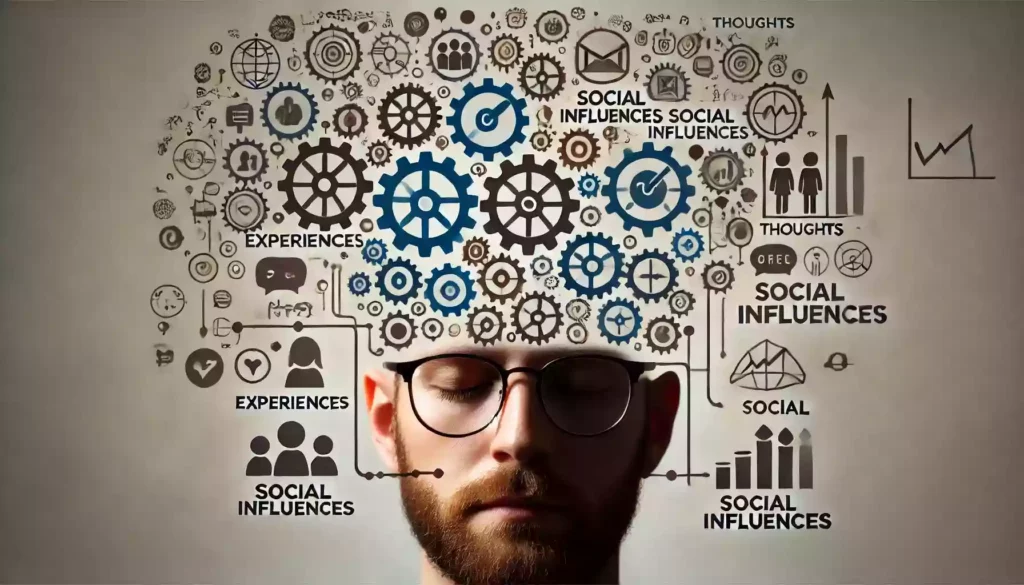Key Takeaways:
- Attitudes shape behaviors
- Formed by experiences
- Change through conscious effort
- Positive attitudes improve life
Have you ever wondered why some people seem to handle life's challenges with grace, while others struggle to stay positive? The answer often lies in their attitudes. Attitudes are more than just thoughts; they are deeply ingrained tendencies that shape how we perceive and interact with the world. They influence our decisions, behaviors, and even our relationships. If you're struggling with a negative attitude, you're not alone. Understanding and changing your attitude can transform your life, leading to better mental health and stronger relationships.
In this article, we will explore what attitudes are, how they form, and the profound impact they have on our lives. We'll delve into practical steps you can take to develop a positive attitude, backed by psychological theories and expert advice. Whether you're dealing with stress at work, conflicts in your personal life, or just a general sense of dissatisfaction, this guide will provide you with the tools to shift your mindset and improve your overall well-being.
What is an Attitude?
An attitude is a psychological construct—a mental and emotional entity that inheres in, or characterizes a person. Attitudes are complex and can significantly influence our thoughts, feelings, and behaviors. They are formed through a combination of personal experiences, social influences, and cognitive processes. Attitudes are not static; they can change over time and with effort.
Psychologist Gordon Allport described an attitude as a "mental and neural state of readiness, organized through experience, exerting a directive or dynamic influence upon the individual's response to all objects and situations with which it is related." This means that attitudes prepare us to respond in particular ways to certain stimuli, and these responses can be positive, negative, or neutral.
Understanding what attitudes are is the first step in learning how to modify them. In the following sections, we'll explore how attitudes form and the ways in which they shape our behavior.
How Attitudes Form

Attitudes are not innate; they are learned over time through various influences. These influences can be broadly categorized into three main areas: personal experiences, social influences, and cognitive processes.
Personal experiences play a crucial role in shaping our attitudes. Positive or negative encounters with people, places, and events leave lasting impressions that contribute to how we feel and think about similar situations in the future. For example, if you had a supportive teacher who encouraged your love for learning, you might develop a positive attitude towards education.
Social influences, including family, friends, and media, also impact attitude formation. From a young age, we observe and mimic the behaviors and attitudes of those around us. If your parents had a particular attitude towards work or relationships, you might find yourself adopting similar views. Additionally, the media we consume—television, movies, social media—can subtly or overtly shape our attitudes by presenting certain perspectives as desirable or undesirable.
Cognitive processes involve the ways we think and interpret the world. Our beliefs, values, and expectations influence how we perceive events and information, which in turn affects our attitudes. Cognitive dissonance theory, proposed by Leon Festinger, suggests that when we experience inconsistency between our beliefs and actions, we feel discomfort. To alleviate this discomfort, we might change our attitudes to align with our actions.
The Impact of Attitudes on Behavior
Attitudes significantly influence our behavior, often in ways we might not immediately recognize. They act as a lens through which we interpret our environment, guiding our responses and decisions. For instance, someone with a positive attitude towards exercise is more likely to engage in physical activities regularly, while someone with a negative attitude might avoid it altogether.
One of the key ways attitudes affect behavior is through the principle of consistency. We strive for harmony between our attitudes and actions, which means we tend to behave in ways that are congruent with our established attitudes. This principle is evident in the theory of planned behavior, which posits that attitudes towards a behavior, subjective norms, and perceived behavioral control together shape an individual's intentions and actions.
Moreover, attitudes can shape our interactions with others. A positive attitude can foster better relationships, as it promotes open communication, empathy, and cooperation. Conversely, a negative attitude can lead to conflicts and misunderstandings, as it often involves defensive or hostile behaviors.
Understanding the impact of attitudes on behavior is essential for personal growth and development. By recognizing how our attitudes influence our actions, we can take conscious steps to adjust them, leading to more positive outcomes in various aspects of life.
Changing Negative Attitudes

Changing negative attitudes is a challenging yet rewarding endeavor. It requires self-awareness, effort, and persistence. The first step is to recognize and acknowledge the negative attitude. This might involve reflecting on your thoughts and behaviors and identifying patterns that consistently lead to negative outcomes.
Once you have identified the negative attitude, it's important to understand its root cause. Often, negative attitudes stem from past experiences, fears, or misconceptions. By addressing these underlying issues, you can begin to alter your perspective. Cognitive-behavioral therapy (CBT) is a popular method used to change negative thought patterns. CBT involves identifying distorted thinking, challenging these thoughts, and replacing them with more positive and realistic ones.
Another effective technique is mindfulness. By practicing mindfulness, you can become more aware of your thoughts and feelings without judgment. This awareness allows you to observe your negative attitudes and gradually shift them towards positivity. Additionally, surrounding yourself with positive influences—people, environments, and media—can help reinforce the desired attitude change.
It's also helpful to set specific, achievable goals related to changing your attitude. For example, if you have a negative attitude towards social situations, you might set a goal to attend one social event per week. Celebrating small successes along the way can boost your confidence and motivate you to continue the journey.
7 Steps to Develop a Positive Attitude
-
Practice Gratitude
Start each day by acknowledging things you're thankful for. Gratitude shifts your focus from what's wrong to what's right.
-
Surround Yourself with Positive People
The company you keep greatly influences your mindset. Spend time with those who uplift and inspire you.
-
Engage in Positive Self-Talk
Challenge negative thoughts and replace them with affirmations. Remind yourself of your strengths and achievements.
-
Set Realistic Goals
Break down your objectives into manageable steps. Celebrate each milestone to maintain motivation and positivity.
-
Practice Mindfulness
Stay present and aware of your thoughts and feelings. Mindfulness helps you manage stress and maintain a balanced outlook.
-
Help Others
Acts of kindness boost your mood and foster a positive attitude. Volunteer or assist someone in need.
-
Maintain a Healthy Lifestyle
Exercise regularly, eat well, and get enough sleep. Physical well-being supports mental positivity.
Conclusion
Developing a positive attitude is not an overnight process, but with dedication and the right strategies, it is entirely achievable. By understanding the nature of attitudes, how they form, and their impact on behavior, you are better equipped to make meaningful changes in your life. Remember, a positive attitude not only enhances your mental and emotional well-being but also positively influences those around you. Start with small steps, be patient with yourself, and celebrate your progress along the way.
Adopting a positive attitude is a journey of self-improvement that opens doors to new opportunities and experiences. As you continue to apply the steps outlined in this article, you will likely notice a significant shift in how you perceive and respond to life's challenges. Stay committed to the process, and you'll find that a positive attitude can indeed transform your life.
FAQs
Q: How long does it take to change a negative attitude?
A: The time it takes to change a negative attitude varies from person to person. It depends on factors like the depth of the negative attitude, the techniques used, and the individual's commitment to change. Consistent effort and practice are key to seeing results.
Q: Can positive affirmations really change my attitude?
A: Yes, positive affirmations can be effective in changing your attitude. They work by reinforcing positive thoughts and beliefs, gradually replacing negative ones. Repeating affirmations regularly can help shift your mindset over time.
Q: What should I do if I struggle to stay positive?
A: It's normal to struggle with maintaining a positive attitude, especially during challenging times. When this happens, try to focus on small, achievable goals, practice self-care, and seek support from friends, family, or a mental health professional.
Q: How can I help someone else develop a positive attitude?
A: You can support someone in developing a positive attitude by being a positive role model, offering encouragement, and sharing strategies that have worked for you. Listening and providing a non-judgmental space for them to express their feelings can also be very helpful.
References
Understanding attitudes and their impact on behavior involves drawing on a wealth of psychological research and expert insights. The following references provide a foundation for the concepts discussed in this article, offering deeper insights into the nature of attitudes and the methods for changing them.
Allport, G. W. (1935). Attitudes. In C. Murchison (Ed.), Handbook of Social Psychology (pp. 798-844). Worcester, MA: Clark University Press.
Festinger, L. (1957). A Theory of Cognitive Dissonance. Stanford, CA: Stanford University Press.
Ajzen, (1991). The theory of planned behavior. Organizational Behavior and Human Decision Processes, 50(2), 179-211.
Additionally, many contemporary articles and studies further explore the practical applications of these theories and provide evidence-based strategies for attitude change and positive thinking.
Recommended Resources
- Carnegie, D. (1936). How to Win Friends and Influence People. New York, NY: Simon & Schuster.
- Burns, D. D. (1980). Feeling Good: The New Mood Therapy. New York, NY: William Morrow & Company.
- Seligman, M. E. P. (2006). Learned Optimism: How to Change Your Mind and Your Life. New York, NY: Vintage Books.

.thumb.jpg.78735a344a3340a866dda54f465baebb.jpg)


Recommended Comments
There are no comments to display.
Create an account or sign in to comment
You need to be a member in order to leave a comment
Create an account
Sign up for a new account in our community. It's easy!
Register a new accountSign in
Already have an account? Sign in here.
Sign In Now